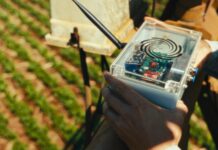By Barry Venter, Nashua CEO
With around 32,000 commercial farms in South Africa, agriculture is a cornerstone of the economy. Yet this business isn’t for the timid, with farmers facing crime and security threats as diverse as livestock and produce theft, shrinkage of removable items and expensive commodities like fuel, illegal grazing and trespassing.
In response to these security challenges, we are seeing many commercial farmers increase their investments into digital technologies such as biometric access control and smart surveillance systems. Not only are these technologies valuable in addressing crime losses, but they are also essential tools for improving worker safety and operational efficiency on the farm.
Protecting a farm isn’t just about defending the perimeter from criminals. Farmers must ensure that the right people have access to the right areas of the farm, from a security as well as an occupational health and safety perspective. Keeping unauthorised personnel away from dangerous areas or valuable assets and commodities is key.
Farmers need to know who has reported for work, or how many people need to be evacuated from a specific area should an emergency occur. If stock goes missing, they want to see who accessed that area most recently. If there’s an accident and someone is injured, farmers want to confirm if they were permitted to be there.
Today’s IP-based cameras, along with sophisticated biometrics access controls, give farmers more visibility and control over their vast and dispersed properties. The technology is gaining traction in agriculture due to rising rural crime, tight margins, and the increasing complexity of managing large, seasonal workforces.
The benefits of this technology include 24/7 remote monitoring; the ability to monitor and control entry and exit into specific areas; and even automatic number plate recognition for vehicles entering the premises to deliver or collect stock. If you operate vehicles, then you can also monitor your vehicles, drivers and cargo, including live camera views and GPS.
Biometrics: Why now?
Biometric access control solutions use unique physical characteristics to verify identity — replacing keys or cards with fingerprint, facial or iris scans. This makes it virtually impossible to duplicate, steal or misuse credentials. Facial and iris recognition is useful on farms where people’s fingerprints may be worn due to physical labour.
Access to hazardous areas like fuel storage, chemical sheds or food processing zones can be limited to trained, authorised personnel. This reduces accidents and improves compliance with occupational health and safety regulations. Biometric logs also help in emergency scenarios, enabling faster evacuation and response.
Biometric clock-ins eliminate shared or lost cards and provide accurate work-hour logging, which is crucial for managing seasonal or shift workers. Integrated systems can automate time and attendance tracking, reducing paperwork and ensuring compliance with labour laws.
CCTV and real-time monitoring
However, smart security doesn’t stop at access points. CCTV and video surveillance are playing an invaluable role in farm-wide safety and productivity. Modern IP-based cameras deliver high-resolution video feeds, even in low-light or wide-area conditions. Footage can be monitored in real time or reviewed after an incident, protecting against theft and vandalism.
Digital cameras and artificial intelligence (AI) turn video streams and recordings into data to support better decision-making. IP-based cameras include features such as motion detection, object tracking, facial recognition, and people counting. These analytics can provide valuable insights into worker behaviour, traffic patterns, and security threats.
Artificial intelligence and video analytics enable farmers to identify suspicious behaviour — like loitering near high-value assets or entering restricted areas. Alerts are sent instantly to farm managers or linked security teams, enabling intervention before incidents escalate.
Tailored for the South African context
While infrastructure constraints and upfront costs can be barriers, newer systems are becoming more affordable and adaptable, including solar-powered and offline-capable options. Farms already using these solutions are seeing reduced theft, better productivity, and improved safety and compliance.
Farms are evolving into high-tech operations — and like any modern business, they require robust systems to protect people, assets, and outputs. By investing in smart surveillance and biometric access control, farmers can secure their operations, gain valuable insights, and build a future-ready foundation for sustainable growth.








